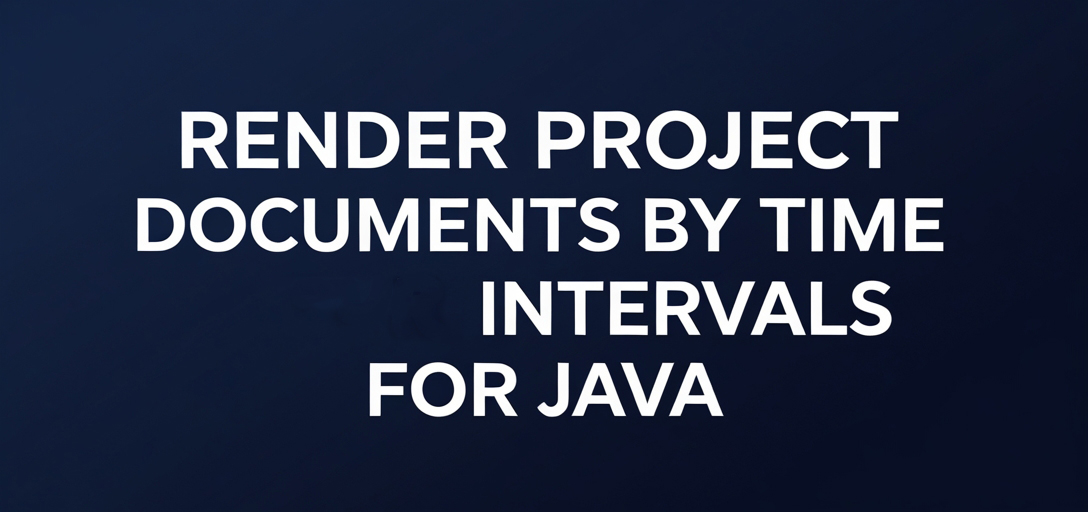How to Implement Render Project Documents with Time Intervals using GroupDocs.Viewer for Java
Introduction
Struggling to render project documents within specific time intervals? This comprehensive tutorial will guide you through solving this problem using the powerful GroupDocs.Viewer API in Java. Whether managing timelines or visualizing project phases, mastering this feature can significantly enhance your document management capabilities.

What You’ll Learn:
- Setting up and configuring GroupDocs.Viewer for Java
- The step-by-step process of rendering project documents within a specified time interval
- Key configuration options and troubleshooting tips
- Real-world applications of this implementation
Let’s start with the prerequisites you need before getting started!
Prerequisites
Before we begin, ensure you have the following:
Required Libraries and Versions:
- GroupDocs.Viewer for Java version 25.2 or higher.
Environment Setup Requirements:
- Java Development Kit (JDK) installed
- Integrated Development Environment (IDE) such as IntelliJ IDEA or Eclipse
Knowledge Prerequisites:
- Basic understanding of Java programming
- Familiarity with Maven project setup
Setting Up GroupDocs.Viewer for Java
To start rendering your project documents, you need to set up the GroupDocs.Viewer library. Here’s how:
Maven Setup
Include the following in your pom.xml file to add GroupDocs.Viewer as a dependency:
<repositories>
<repository>
<id>repository.groupdocs.com</id>
<name>GroupDocs Repository</name>
<url>https://releases.groupdocs.com/viewer/java/</url>
</repository>
</repositories>
<dependencies>
<dependency>
<groupId>com.groupdocs</groupId>
<artifactId>groupdocs-viewer</artifactId>
<version>25.2</version>
</dependency>
</dependencies>
License Acquisition Steps
- Free Trial: Download a trial version from GroupDocs’ download page.
- Temporary License: Obtain a temporary license for extended testing via this link.
- Purchase: For full access, purchase a license at GroupDocs Purchase Page.
Basic Initialization
With GroupDocs.Viewer set up, you can initialize it in your Java application:
import com.groupdocs.viewer.Viewer;
public class ViewerSetup {
public static void main(String[] args) {
try (Viewer viewer = new Viewer("path/to/your/document.mpp")) {
// Your rendering code goes here
}
}
}
Implementation Guide
This section covers how to render project documents within a specified time interval using GroupDocs.Viewer.
Rendering Project Documents with Time Intervals
Overview
This feature allows you to display specific portions of your project schedule, aiding in effective timeline management and analysis.
Step-by-Step Guide
1. Define the Output Directory
Set up where the rendered HTML files will be stored:
import java.nio.file.Path;
Path outputDirectory = Path.of("YOUR_OUTPUT_DIRECTORY", "RenderProjectTimeInterval");
Path pageFilePathFormat = outputDirectory.resolve("page_{0}.html");
Why This Step?: Establishing a dedicated output directory helps organize and manage rendered documents efficiently.
2. Initialize Viewer
Load your source document using GroupDocs.Viewer:
try (Viewer viewer = new Viewer("YOUR_DOCUMENT_DIRECTORY/SAMPLE_MPP")) {
// Continue with rendering steps
}
Why This Step?: Loading the document initializes the viewer and prepares it for rendering.
3. Retrieve View Information
Get specific view information tailored to project management documents:
import com.groupdocs.viewer.options.ViewInfoOptions;
import com.groupdocs.viewer.results.ProjectManagementViewInfo;
ViewInfoOptions viewInfoOptions = ViewInfoOptions.forHtmlView();
ProjectManagementViewInfo viewInfo = (ProjectManagementViewInfo) viewer.getViewInfo(viewInfoOptions);
Why This Step?: Acquiring project-specific view information is crucial for setting the correct time intervals.
4. Set Up HTML Rendering Options
Configure options to render your document as HTML with embedded resources:
import com.groupdocs.viewer.options.HtmlViewOptions;
HtmlViewOptions viewOptions = HtmlViewOptions.forEmbeddedResources(pageFilePathFormat);
viewOptions.getProjectManagementOptions().setStartDate(viewInfo.getStartDate());
viewOptions.getProjectManagementOptions().setEndDate(viewInfo.getEndDate());
Why This Step?: Setting the start and end dates ensures that only relevant sections of your project document are rendered.
5. Render the Project Document
Finally, execute the rendering process:
viewer.view(viewOptions);
Why This Step?: Rendering transforms your configuration into a visual output in HTML format.
Troubleshooting Tips:
- Ensure all file paths are correctly specified.
- Double-check that the document type is supported by GroupDocs.Viewer for project management features.
Practical Applications
- Project Timeline Analysis: Visualize specific phases of your projects to analyze progress and resource allocation.
- Reporting: Generate time-bound reports for stakeholders showcasing completed milestones.
- Integration with Project Management Tools: Enhance existing tools with custom timeline views using rendered documents.
- Data Archiving: Archive project documentation in a web-friendly format for easy access and sharing.
Performance Considerations
To optimize performance when rendering large documents:
- Use embedded resources to keep HTML files self-contained.
- Monitor memory usage, especially when dealing with extensive timelines or datasets.
- Implement efficient file handling practices within your Java application.
Conclusion
By following this guide, you now have the skills to render project documents within specified time intervals using GroupDocs.Viewer for Java. This capability can significantly enhance your document management and reporting processes.
Next Steps:
Explore additional features of GroupDocs.Viewer, such as watermarking or security settings, to further customize your document rendering solutions.
Call-to-Action
Try implementing this solution in your project today and see how it streamlines your documentation process!
FAQ Section
1. What file formats does GroupDocs.Viewer support? GroupDocs.Viewer supports a wide range of document types including Microsoft Project (MPP), PDF, Word, Excel, and more.
2. How do I get started with a free trial of GroupDocs.Viewer? You can download the trial version from here.
3. Can I render documents without embedding resources? Yes, you can choose to render documents without embedded resources by using different HTML view options.
4. What if my document is too large for rendering? Consider optimizing your document or breaking it into smaller parts before rendering.
5. How do I handle rendering errors? Ensure all configurations are correct and check the GroupDocs documentation for error handling techniques.
Resources
- Documentation: GroupDocs Viewer Java Documentation
- API Reference: GroupDocs API Reference
- Download: GroupDocs Downloads
- Purchase: Buy GroupDocs License
- Free Trial: Try the Free Version
- Temporary License: Get a Temporary License
- Support: GroupDocs Forum
With this guide, you are ready to implement time interval rendering in your projects using GroupDocs.Viewer for Java.